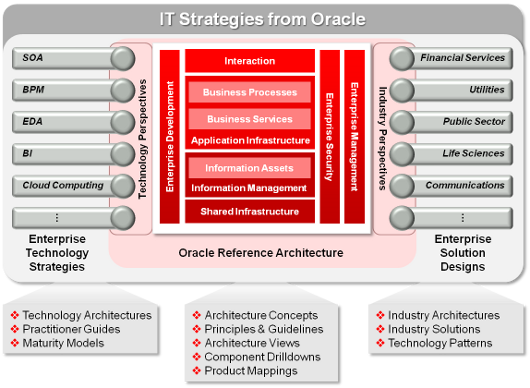
The IT Strategies from Oracle give you a whole library of whitepapers, not only to develop a Reference Architecture for your own, by adapting the ORA to your needs, but it also focuses on the surrounding Enterprise Technology Strategies and Enterprise Solution Designs. In other words, ITSO covers both the horizontal technology perspectives (SOA, BPM, EDA, etc.), but also the vertical business perspectives (Utilities, Government, etc.).
Now, in case you think that this is all about Oracle Technology products, you might be surprised: the whole ITSO / Oracle Reference Architecture is Vendor-Neutral. It is only scoped to Oracle's product portfolio. Now, one might ask themselves: what technology product area's doesn't Oracle have products for, so that shouldn't be too much of an issue as far as completeness is concerned.
ITSO can help you organizing complex product landscapes, by means of a holistic approach to technology adoption. By covering the technology as a whole, you can reduce risk and become more in control of your IT solutions.
The ITSO, and, being part of it, the Oracle Reference Architecture is not an Architecture Framework. For this, many solutions are already available, of which TOGAF and Oracle's Enterprise Architecture Framework (OEAF) are good examples. The ORA can be perfectly integrated in any of the currently available frameworks.
If you are interested in the ITSO, please visit www.oracle.com/goto/itstrategies, you will find a great deal of information there:
Oracle Reference Architectures
These cover
- Application Infrastructure Foundation,
- Service Orientation,
- Service-Oriented Integration,
- Software Engineering,
- Security,
- Management and Monitoring
Enterprise Technology Strategies for Service-Oriented Architecture
Practitioner Guides
- SOA Foundation
- Creating an SOA Roadmap,
- Frameworks for Governance,
- Identifying Services,
- Determining ROI,
- Software Engineering
Enterprise Technology Strategies for Business Process Management
These documents contain
- BPM Foundation
- BPM Infrastructure
- Practitioner Guide on Creating a BPM Roadmap
Be sure to check it out!

